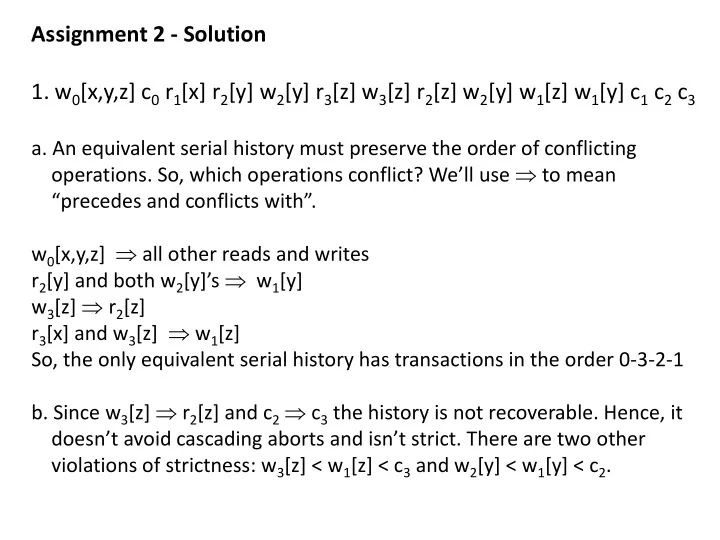

Assignment 2 - Solution 1. w 0 [x,y,z] c 0 r 1 [x] r 2 [y] w 2 [y] r 3 [z] w 3 [z] r 2 [z] w 2 [y] w 1 [z] w 1 [y] c 1 c 2 c 3 a. An equivalent serial history must preserve the order of conflicting operations . So, which operations conflict? We’ll use to mean “precedes and conflicts with”. w 0 [x,y,z] all other reads and writes r 2 [y] and both w 2 [y]’s w 1 [y] w 3 [z] r 2 [z] r 3 [x] and w 3 [z] w 1 [z] So, the only equivalent serial history has transactions in the order 0-3-2-1 b. Since w 3 [z] r 2 [z] and c 2 c 3 the history is not recoverable. Hence, it doesn’t avoid cascading aborts and isn’t strict. There are two other violations of strictness: w 3 [z] < w 1 [z] < c 3 and w 2 [y] < w 1 [y] < c 2 .
2. w 0 [x,y,z] c 0 r 1 [x] r 2 [y] w 2 [y] r 3 [z] r 2 [z] w 2 [y] w 1 [z] w 1 [y] c 1 c 2 c 3 (same as (1), except delete w 3 [z] ) a. We no longer have w 3 [z] r 2 [z]. So the order of T 3 relative to T 2 is unconstrained. Therefore, the history is now equivalent to a serial history with transactions in the order 0-3-2-1 or 0-2-3-1. b. The history is now recoverable and avoids cascading aborts. But it still isn’t strict because w 3 [z] < w 1 [z] < c 3 and w 2 [y] w 1 [y] c
3. w 0 [x,y,z] c 0 r 1 [x] r 2 [y] w 2 [y] r 3 [z] w 3 [z] r 2 [z] w 2 [y] w 1 [z] w 1 [y] c 1 c 3 c 2 (same as (1), except that c 2 is moved after c 3 ) a. This has no effect on serializability, so the answer is the same as 1a. b. This also makes the history recoverable, since w 3 [z] r 2 [z] and c 3 c 2 . But it still doesn’t avoid cascading aborts, because of the same conflict: T 2 reads uncommitted data (z) from T 3 . Obviously, it is not strict.
4. w 0 [x,y,z] c 0 r 1 [x] r 2 [y] w 2 [x] r 3 [z] w 3 [z] r 2 [z] w 2 [y] w 1 [z] w 1 [y] c 1 c 2 c 3 (same as (1), except the first w 2 [y] becomes w 2 [x]) a. Now we have r 1 [x] w 2 [x] and w 2 [y] w 1 [y] forming a cycle, so there is no equivalent serial history. b. w 3 [z] r 2 [z] and c 2 c 3 is unchanged from (1), so the history is not recoverable since T 2 reads uncommitted data.
5. w 0 [x,y,z] c 0 r 1 [x] r 2 [y] w 2 [y] r 3 [z] w 3 [z] r 2 [z] w 2 [y] c 2 w 1 [z] w 1 [y] c 1 c 3 (same as (1), except c 2 is moved before w 1 [z]) a. This has no effect on serializability b. It is tempting to think that this helps strictness, since we now have w 3 [z] < c 3 < w 1 [z] and w 2 [y] < c 2 < w 1 [y]. But strictness implies avoidance of cascading aborts, which implies recoverability. And we still have the same old violation of recoverability: T 2 still reads uncommitted data (z) from T 3 . So the execution isn’t strict.
Recommend
More recommend